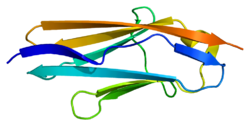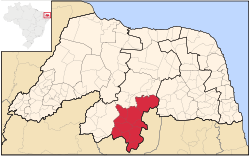SPEG
SPEG| SPEG | |||||||||||||||||||||||||
|---|---|---|---|---|---|---|---|---|---|---|---|---|---|---|---|---|---|---|---|---|---|---|---|---|---|
 | |||||||||||||||||||||||||
| |||||||||||||||||||||||||
| 식별자 | |||||||||||||||||||||||||
| 별칭 | SPEG, APEG-1, APEG1, BPEG, SPEG알파, SPEG베타, CNM5, SPEG 복합 로커스, MYLK6, 분해된 근육농축 단백질 키나아제 | ||||||||||||||||||||||||
| 외부 ID | OMIM: 615950 MGI: 109282 HomoloGene: 55619 GeneCard: SPEG | ||||||||||||||||||||||||
| |||||||||||||||||||||||||
| |||||||||||||||||||||||||
| |||||||||||||||||||||||||
| |||||||||||||||||||||||||
| 직교체 | |||||||||||||||||||||||||
| 종 | 인간 | 마우스 | |||||||||||||||||||||||
| 엔트레스 | |||||||||||||||||||||||||
| 앙상블 | |||||||||||||||||||||||||
| 유니프로트 | |||||||||||||||||||||||||
| RefSeq(mRNA) | |||||||||||||||||||||||||
| RefSeq(단백질) | |||||||||||||||||||||||||
| 위치(UCSC) | Chr 2: 219.43 – 219.49Mb | Cr 1: 75.38 – 75.43Mb | |||||||||||||||||||||||
| PubMed 검색 | [3] | [4] | |||||||||||||||||||||||
| 위키다타 | |||||||||||||||||||||||||
| |||||||||||||||||||||||||
줄무늬근육은 단백질 키나아제를 우선적으로 발현하는데, 인체 내에서는 미오신 라이트 체인 키나아제 단백질 계열의 하나인 SPEG 유전자에 의해 암호화된다.[5][6][7]SPEG는 근육 세포 세포의 세포골격의 발달에 관여하고 있으며, 이 유전자의 발현은 골격근육의 발달과 그 유지와 기능에 중요한 역할을 한다.[5][7]돌연변이는 세포핵이 비정상적으로 중앙에 위치하는 선천성 질환의 집단인 100핵 근종과 연관된다.[8]
생쥐에서 이 유전자는 SPEG complex locus라고 불린다.[9]이 유전자의 발현은 이 세포 유형의 성장과 분화를 조절하는 역할을 할 수 있는 차별화된 혈관 매끄러운 근육 세포의 표식 역할을 하는 것으로 생각된다.인코딩된 단백질은 해당 쥐와 생쥐 단백질과 매우 유사하다.이 유전자에 대해 여러 개의 대안으로 분할된 대본 변형이 발견되었지만, 오직 한 변종의 전체 길이 특성이 정의되었다.
| Speg용 마우스 돌연변이 알레르기가 있음 | ||
|---|---|---|
| 마우스 유전자의 마커 기호.이 기호는 MGI에 의해 게놈 위치에 할당된다. | 스피그 | |
| 돌연변이 생쥐 배아 줄기세포 복제.이것들은 쥐의 유전자에 대해 알려진 표적 돌연변이들이다. | 스피그tm1a(KOMP)Wtsi | |
| 이 유전자에 대한 표적 조건부 돌연변이 알레르기의 구조 예 | ||
| 이 돌연변이 ES 세포는 직접 연구하거나 이 유전자를 녹아웃시킨 쥐를 생성하는 데 사용될 수 있다.이 쥐들에 대한 연구는 Speg의 기능을 밝혀낼 수 있다. | ||
참조
- ^ a b c GRCh38: 앙상블 릴리스 89: ENSG000072195 - 앙상블, 2017년 5월
- ^ a b c GRCm38: 앙상블 릴리스 89: ENSMUSG000026207 - 앙상블, 2017년 5월
- ^ "Human PubMed Reference:". National Center for Biotechnology Information, U.S. National Library of Medicine.
- ^ "Mouse PubMed Reference:". National Center for Biotechnology Information, U.S. National Library of Medicine.
- ^ a b "SPEG striated muscle enriched protein kinase [Homo sapiens (human)] - Gene - NCBI". www.ncbi.nlm.nih.gov. Retrieved 6 June 2021.
- ^ "SPEG - Striated muscle preferentially expressed protein kinase - Homo sapiens (Human) - SPEG gene & protein". www.uniprot.org. Retrieved 6 June 2021.
- ^ a b Luo, S; Rosen, SM; Li, Q; Agrawal, PB (2021-05-27). "Striated Preferentially Expressed Protein Kinase (SPEG) in Muscle Development, Function, and Disease". International Journal of Molecular Sciences. 22 (11): 5732. doi:10.3390/ijms22115732. PMC 8199188. PMID 34072258.
- ^ Zhang, G; Xu, M; Huang, T; Lin, W; Chen, J; Chen, W; Chang, X (2021-04-29). "Clinical and genetic analysis of a case with centronuclear myopathy caused by SPEG gene mutation: a case report and literature review". BMC Pediatrics. 21 (1): 209. doi:10.1186/s12887-021-02656-6. PMC 8082920. PMID 33926407.
- ^ "Speg SPEG complex locus [Mus musculus (house mouse)] - Gene - NCBI". www.ncbi.nlm.nih.gov. Retrieved 6 June 2021.
추가 읽기
- Hsieh CM, Yoshizumi M, Endege WO, et al. (1996). "APEG-1, a novel gene preferentially expressed in aortic smooth muscle cells, is down-regulated by vascular injury". J. Biol. Chem. 271 (29): 17354–9. doi:10.1074/jbc.271.29.17354. PMID 8663449.
- Hsieh CM, Yet SF, Layne MD, et al. (1999). "Genomic cloning and promoter analysis of aortic preferentially expressed gene-1. Identification of a vascular smooth muscle-specific promoter mediated by an E box motif". J. Biol. Chem. 274 (20): 14344–51. doi:10.1074/jbc.274.20.14344. PMID 10318857.
- Nagase T, Kikuno R, Ishikawa KI, et al. (2000). "Prediction of the coding sequences of unidentified human genes. XVI. The complete sequences of 150 new cDNA clones from brain which code for large proteins in vitro". DNA Res. 7 (1): 65–73. doi:10.1093/dnares/7.1.65. PMID 10718198.
- Strausberg RL, Feingold EA, Grouse LH, et al. (2003). "Generation and initial analysis of more than 15,000 full-length human and mouse cDNA sequences". Proc. Natl. Acad. Sci. U.S.A. 99 (26): 16899–903. doi:10.1073/pnas.242603899. PMC 139241. PMID 12477932.
- Ota T, Suzuki Y, Nishikawa T, et al. (2004). "Complete sequencing and characterization of 21,243 full-length human cDNAs". Nat. Genet. 36 (1): 40–5. doi:10.1038/ng1285. PMID 14702039.
- Sutter SB, Raeker MO, Borisov AB, Russell MW (2005). "Orthologous relationship of obscurin and Unc-89: phylogeny of a novel family of tandem myosin light chain kinases" (PDF). Dev. Genes Evol. 214 (7): 352–9. doi:10.1007/s00427-004-0413-5. hdl:2027.42/47514. PMID 15185077. S2CID 7676954.
- Gerhard DS, Wagner L, Feingold EA, et al. (2004). "The Status, Quality, and Expansion of the NIH Full-Length cDNA Project: The Mammalian Gene Collection (MGC)". Genome Res. 14 (10B): 2121–7. doi:10.1101/gr.2596504. PMC 528928. PMID 15489334.
- Arvanitis DA, Flouris GA, Spandidos DA (2005). "Genomic rearrangements on VCAM1, SELE, APEG1and AIF1 loci in atherosclerosis". J. Cell. Mol. Med. 9 (1): 153–9. doi:10.1111/j.1582-4934.2005.tb00345.x. PMC 6741330. PMID 15784173.
- Hillier LW, Graves TA, Fulton RS, et al. (2005). "Generation and annotation of the DNA sequences of human chromosomes 2 and 4". Nature. 434 (7034): 724–31. Bibcode:2005Natur.434..724H. doi:10.1038/nature03466. PMID 15815621.
- Manjasetty BA, Niesen FH, Scheich C, et al. (2006). "X-ray structure of engineered human Aortic Preferentially Expressed Protein-1 (APEG-1)". BMC Struct. Biol. 5: 21. doi:10.1186/1472-6807-5-21. PMC 1352370. PMID 16354304.
- Tam JL, Triantaphyllopoulos K, Todd H, et al. (2006). "The human desmin locus: gene organization and LCR-mediated transcriptional control". Genomics. 87 (6): 733–46. doi:10.1016/j.ygeno.2006.01.009. PMID 16545539.
외부 링크
- UCSC 게놈 브라우저에서 SPEG 인간 유전자 위치.
- UCSC 게놈 브라우저의 SPEG 인간 유전자 세부 정보.








